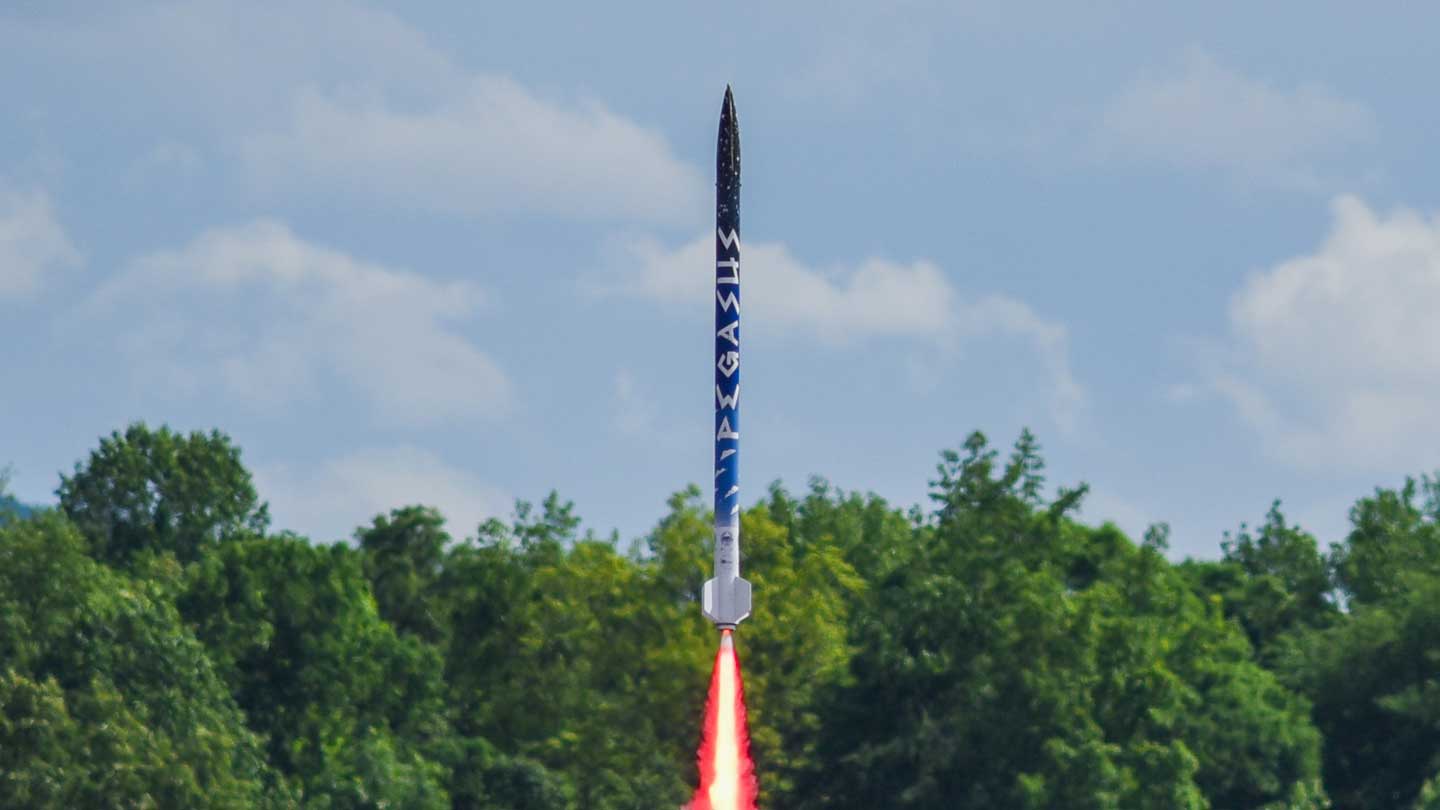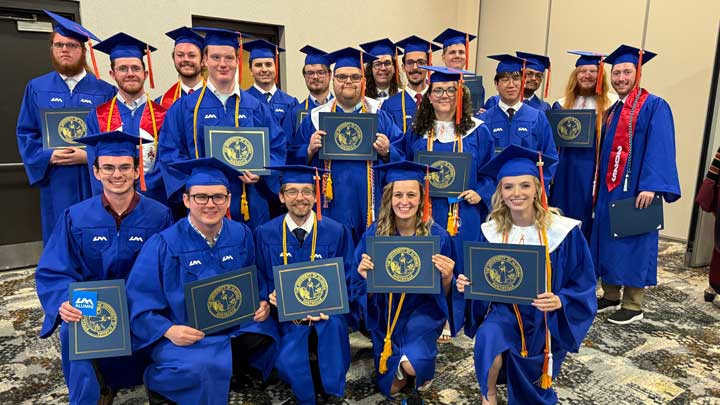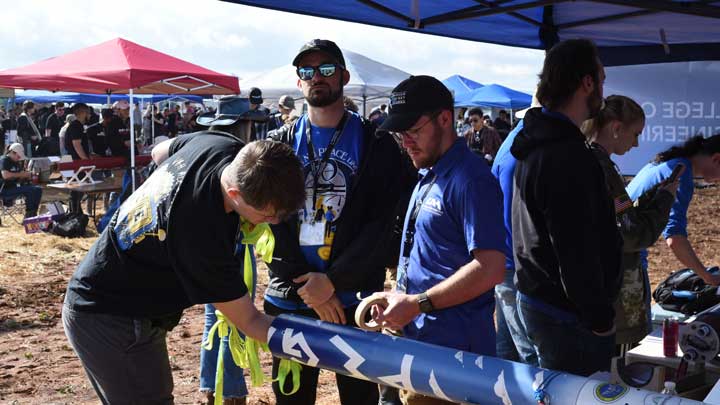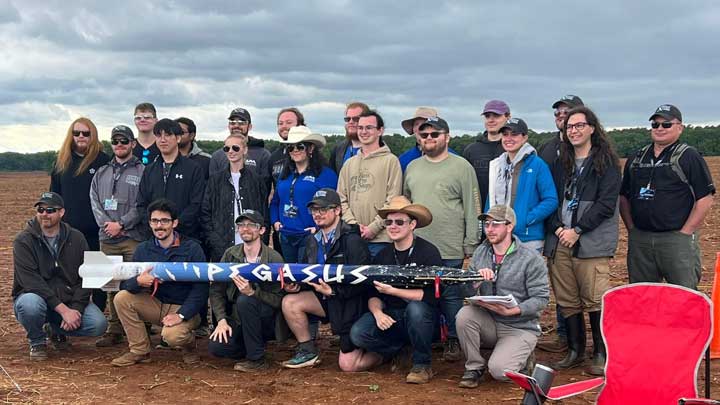
Successful launch of UAH Pegasus rocket near Marshall Space Flight Center as part of NASA Artemis Student Launch Challenge.
Courtesy Ocean Bowling
A student team from The University of Alabama in Huntsville (UAH), a part of The University of Alabama System, placed third in the 2025 NASA Student Launch Challenge – University Student Launch Initiative (USLI). The 25th annual competition saw 53 teams from colleges and universities across the U.S. face off in one of NASA's Artemis Student Challenges. The project involved hundreds of participants from across the U.S. and Puerto Rico designing, building, testing and launching a high-powered rocket carrying a scientific or engineering payload near NASA Marshall Space Flight Center (MSFC) in Huntsville, Ala.
“The mission this year required the team to design a capsule that carried simulated astronauts – STEMnauts – and to autonomously send data to a NASA ground station reporting specific measurements related to survivability of the STEMnauts after landing,” explains UAH team advisor, Dr. David Lineberry, a principal research engineer for the UAH Propulsion Research Center and team advisor.

UAH mechanical and aerospace seniors graduate together as a team, May, 2025.
Courtesy Ocean Bowling
The goal of the STEMnaut “crew” was to relay real-time data to the student team's mission control, just as the Artemis astronaut crew will do as they explore the lunar surface. “Because of an electronics component failure at the launch field, the UAH team had to make an ‘on the field’ repair using components from the team's ground station to ensure the payload would work as intended,” Lineberry says. “Because of that fix, the team had no way to know if the payload reported results or not until they recovered the rocket. So, the payload team was a little anxious until the rocket was recovered and the on-board data logs could be evaluated.”
The weather leading up to the launch and on launch day itself proved to be one of the biggest obstacles to overcome for this year’s challenge. “NASA ended up pushing launch day from Saturday to Sunday because of heavy rain,” Lineberry says. “On launch day, clouds and rain forced some long delays between launches and launch volleys, but all of the teams that attended launch day were able to make launch attempts.”
USLI launch day video
“When the UAH team finally got their launch window, the launch went very well,” Lineberry says. “The rocket reached an apogee within 30 feet of their target altitude, and the rocket recovery system performed as designed to safely land the rocket back within the launch field. Their altitude was the second closest to target for the competition.”
The teams competed for prizes in nearly a dozen categories, including safety, vehicle design and social media presence, as well as science, technology, engineering and math (STEM) engagement. The MSFC Office of STEM Engagement hosts Student Launch to encourage students to pursue careers in STEM through real-world experiences.

UAH team prepares Pegasus rocket for launch.
Courtesy Ocean Bowling
The UAH squad received ample support from the Alabama Space Grant Consortium, Amentum, the National Space Club, Axient, Bild and Women in Defense – Tennessee Valley Chapter, as well as team mentor Jason Winningham, a research engineer with the UAH Center for Cybersecurity Research and Education.
“These organizations provided funding and technical reviewers that really helped make the team successful,” Lineberry says. “And I don't think I can find enough words to adequately describe how much Jason does for the UAH student launch team. He provides so much technical guidance and mentorship and serves as their flyer of record for all launches. So, he, like the students, spends lots of time on weekends supporting team launches. Jason is a huge part in helping the students be successful.”
UAH team participants also earn credits for competing in the USLI through a mechanical and aerospace engineering (MAE) senior design course, MAE 490/491. The team members graduated together this May.
“I was excited to be a part of UAH's USLI team, but also extremely nervous,” says Ocean Bowling, UAH team lead. “I felt a lot of pressure to prove my skills – not just to others, but to myself. One of my favorite moments was our final test launch in Samson, Ala. After weeks of long nights filled with subsystem testing, redesigns and integration with the vehicle, we flew what I’d consider a ‘textbook launch.’ One of the biggest things I had to learn was how to balance being a friend and being a leader – how to hold people accountable while still maintaining mutual respect and trust. It taught me a lot about communication and leading with empathy.”
Looking ahead, the aerospace grad plans to continue building toward a career in the aerospace industry while continuing to explore leadership roles.

Courtesy Ocean Bowling
“Serving as team lead showed me how much I enjoy managing complex projects, coordinating teams and helping others succeed,” Bowling says. “UAH has played a key role in preparing me for the future, not just as an engineer, but as a well-rounded individual. The NASA USLI competition gave me hands-on leadership experience in a high-pressure, multidisciplinary environment, and the support from faculty helped me grow both technically and professionally. I'm confident that the foundation I've built at UAH will continue to support my development as both an engineer and a leader.”
UAH Team Members
- Zachary Blowers, Aerospace Engineering
- Ocean Bowling, Aerospace Engineering
- Gage Brewer, Mechanical Engineering
- McClellan Buckhalter, Aerospace Engineering
- Lohit Chimalapati, Aerospace Engineering
- Taeung Choi, Aerospace Engineering
- Marianna Davis, Aerospace Engineering
- Christopher DiSalvo, Aerospace Engineering
- Alexandria Erickson, Aerospace Engineering
- Charles Frey, Mechanical Engineering
- Kaitlyn Judd, Aerospace Engineering
- Grayson Marrs, Aerospace Engineering
- Nicholas McGarry, Aerospace Engineering
- Preston McGee, Aerospace Engineering
- Ethan Miller, Aerospace Engineering
- Connor Porthouse, Aerospace Engineering
- Tyler Price, Aerospace Engineering
- Christopher Shiffer, Aerospace Engineering
- Jake Thompson, Aerospace Engineering
- Gabi Vest, Aerospace Engineering
- Thomas Waterman, Aerospace Engineering
- James Wilkinson, Aerospace Engineering
- Jacob Williams, Aerospace Engineering